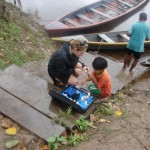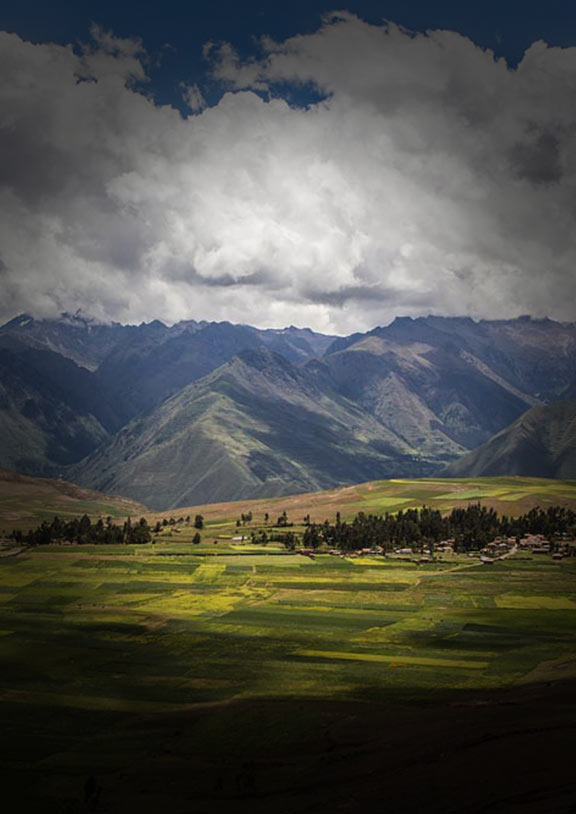Cusco was once the thriving capital of the Inca Empire. Today, Cusco is a bustling town that holds a wealth of pre-Inca, Inca, and colonial history. Like many ancient cities in the world, Cusco‘s grandeur was built over centuries.
In the heart of Cusco sits Coricancha, the Inca Empire’s most important temple. Coricancha, also spelled Koricancha or Qorikancha, means “Golden Temple” in Quechua. This impressive Inca Temple of the Sun continues to be a key feature of the city for locals and tourists alike.
Table of Contents
- Inca Beliefs
- History of Coricancha
- Coricancha Architecture
- Santo Domingo Church
- Plan Your Visit to Coricancha
Last updated by Melissa Dreffs in July 2020.

Coricancha’s courtyard. Photo by Ana Castañeda Cano.
Inca Beliefs
The connection between the earth and celestial bodies greatly influenced local beliefs. The Inca were talented astronomers who built observatories throughout the region. The locations of their sacred sites, including Machu Picchu, were chosen based on celestial synchronicity.
The Incas built the Temple of the Sun in Cusco as a sacred place to honor the Inca Sun God, Inti. With this in mind, they built Coricancha in perfect alignment with stellar and planetary motion. This synchronicity allows for a direct stream of sunlight to enter through its windows every solstice during Inti Raymi – the Festival of the Sun.
The Quechua people also believe in the power of nature and natural forces. Inca temples were often built near sacred places such as caves, mountains, and rivers. As a result of these beliefs, Coricancha sits on a natural hill nestled between two rivers, Shapy-Huatanay and Tullumayo.
Due to the imposition of Christianity by the Spanish, the majority of Peruvians now identify as Catholic. Nonetheless, due to the resilience of the naturalistic Andean worldview, many Peruvians also carry these ancestral beliefs.

Star map at Coricancha. Photo by Peru for Less.
History of Coricancha
Following the legends and history of the Incas, Manco Capac, the first Inca, and his wife Mama Ocllo travelled the Andean landscape from Lake Titicaca until they reached the center of the world, Q’osco. Q’osco, now known as Cusco, means bellybutton in Quechua. Here, at the center of the world, they found the right location to build the most important temple for their kingdom.
Manco Capac initiated the construction of the Temple of the Sun around the year 1200. The temple was initially known as Inticancha, with Inti meaning sun and cancha meaning temple. Years later, Inca Pachacutec restructured the temple and covered it in gold. As a result, the name changed to Coricancha, with cori meaning golden.
The temple walls were plated with 700 gold sheets. According to chroniclers of the time, each sheet depicted one of the divine Inca Gods: Inti (sun), Killa (moon), Chaska (stars) and Illapa (thunder/lighting/rainbow). Similarly, the temple’s garden was dedicated to Wiracocha (creator of the universe) and was adorned with silver and gold life-size statues of alpacas, corn and people.
Unfortunately, the Spanish ransacked the magnificent wealth of Coricancha during their conquest. The Spanish captured the last ruling Inca, Atahualpa. In exchange for his freedom, his people gave Coricancha’s gold as part of the ransom. Nonetheless, the Spanish executed Atahualpa in 1533, after they received the gold.
Atahualpa’s death marked the beginning of the end for the Inca Empire. Tupac Amaru II led several uprisings, but the Spanish captured and brutally executed him as well. The empire never regained its power.

The gardens of Coricancha. Photo by JD Lasica on Flickr.
Coricancha Architecture
The Incas built Coricancha using many of their common architectural techniques and styles. Some of the most prominent styles seen at Coricancha include the vertical inclination of walls, trapezoidal shape of the structures, irregular shapes, and rounded edges, for example.
The stones used to build Coricancha include diorite rocks, Andesites, and calcareous rocks. The Inca extracted the stones 20 miles outside Cusco in the towns Waqoto and Rumicolca. The Coricancha temple is representative of the Incas’ precise stone masonry technique known as ashlar. The Inca cut and shaped stones to fit perfectly against each other without mortar. The stones simply lay on top of each other with no space in between.
Like all Inca Empire architecture, Coricancha’s stone structure is brilliantly designed to withstand seismic activity. Increased breadth on the bottom coupled with 3 to 5 degree inclination give the walls remarkable stability that has withstood centuries of earthquakes. The staggered and mortar-free placement of the stones also makes them resistant to strong earthquakes. The stones can easily wiggle in place, which releases the seismic stresses. After an earthquake, they settle and lock back into their original position. These methods combine to make the structures basically earthquake proof.

The facade of Coricancha. Photo by Jorge Láscar on Flickr.
Santo Domingo Church
Above all, Coricancha depicts the meeting of two worlds. Western religion towers over the foundations of indigenous culture at this site. After the Spanish invasion, Juan Pizarro, the younger brother of Spanish conquistador Francisco Pizarro, gained ownership of the site. Upon his death in 1536, he gifted the site to the Dominicans. In the 16th century, the church built the Santo Domingo monastery on top of the sacred Inca temple. The Dominicans still own the site today.
To build the church of Santo Domingo, the Spanish used stones and other construction material from the sacred Coricancha temple. While the Spanish structure has collapsed several times, the Inca structure remains unchanged and unaffected by the seismic activity.
However, visitors should not disregard the church’s architecture. It is an impressive example of Spanish architecture complete with Baroque-style decorative carvings and vaulted ceilings. Spanish arcades surround the internal courtyard. Moreover, the wooden door boasts Mudéjar (Moorish) style carvings. Santo Domingo is the only place in Cusco representing this style.

Santo Domingo church surrounding its courtyard. Photo by Peru for Less.
Plan Your Visit to Coricancha
- Hours: The site opens daily from 08:30 AM – 05:30 PM. The site may be closed or have reduced hours on holidays.
- Cost: Tickets purchased at the door cost 10 soles ($3.33 USD) per person. Any Cusco tour booked with Peru for Less includes entrance tickets.
- Location: Coricancha (Qorikancha) sits at the intersection of Calle Santo Domingo and Avenida el Sol in Cusco’s Plazoleta Santo Domingo.
Experience the remarkable Inca Sun Temple, Coricancha, and all of Cusco’s highlights on your trip to Peru. Contact Peru For Less to start planning your trip!

Steff is a traveler at heart and the wildness of South America never seizes to captivate her exploratory spirit. While she spent a majority of her childhood in the United States as a free-range “Austinite”, she was born in Peru and feels a deep connection to this continent. She has been fortunate to experience the remarkable landscapes and diversity of Chile, Venezuela, Brazil and Peru.









